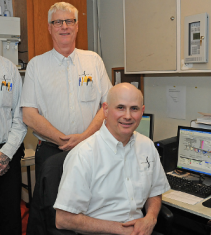Jerry Vanderwerf, chief engineer for the Congress Center office building, is never satisfied with the status quo. He implements energy performance benchmarking tools to monitor how the building operates in real time.

Jerry Vanderwerf, chief engineer for the Congress Center office building, is never satisfied with the status quo. He taps Energy Trust of Oregon and a slate of trusted vendors to help with technical solutions for saving energy, and he implements energy performance benchmarking tools to monitor how the building operates in real time.
Owned by Shorenstein Properties LLC since 2007, the Congress Center is a 370,000-square-foot Class A office building built in 1980. One of the most efficiently-run properties in the national real estate company’s portfolio, the building is certified Leadership in Energy and Environmental Design, LEED®, Gold and earned a 2015 EPA-certified ENERGY STAR® rating of 93 points out of 100.
Shorenstein tracks the environmental performance of its properties closely and sets ambitious improvement targets, including a 20 percent reduction in energy use portfolio-wide by 2020.
Data powers energy-saving practices
Congress Center has a history of successfully implementing energy-saving improvements. The company participated in BetterBrick’s regional 2013 Kilowatt Crackdown competition and won first place for Highest-Performing Building.
The company has also worked with Energy Trust to install variable frequency drives on mechanical equipment, an advanced lighting control system with occupancy sensors and LED lighting in exit signage and elevator cabs.
Most recently, the Congress Center participated in Energy Trust’s Strategic Energy Management initiative to find even more energy savings from operations and maintenance improvements.
An energy management system automates most building functions to improve energy efficiency, although Vanderwerf monitors the schedule constantly to compare performance with his benchmarking tools. Most building engineers wait for their automated system to alert them to problems, while Vanderwerf looks for problems and solves them before they cause issues for tenants.
Congress Center has used ENERGY STAR Portfolio Manager® to benchmark energy use since 2007. In that time, building energy use intensity has dropped 18 percent, translating to an increase in the ENERGY STAR score from 82 to 93, out of 100.
Tenant comfort drives strategy
Tenant comfort and happiness is central to the building management strategy.
“Our sustainable footprint is definitely a leasing advantage,” said Kim Gach, general manager, Congress Center. “This is a box that many current and prospective tenants want to check, and it helps us secure companies who share these values. Building expenses have an impact on leasing rates, so the lower our expenses, the more attractive we become as a potential location.”
“Across our national portfolio, and especially in Oregon, tenants consistently rate sustainability as very important to their leasing decision,” added Jaxon Love, sustainability program manager, Shorenstein Properties. “Congress Center stands out as a high-performing building thanks to the skill and hard work of our engineering and property management team.”



